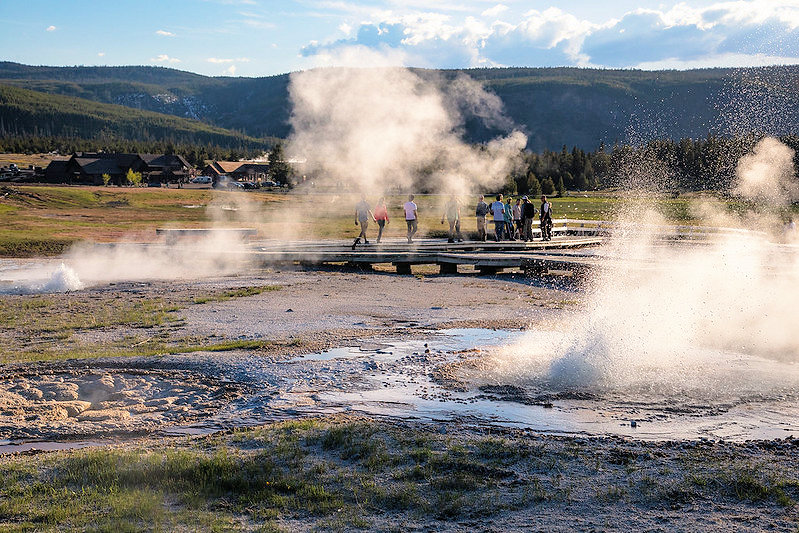
Anemone is one of the easiest geysers to see in the Upper Geyser Basin. There is usually an eruption here every 10 minutes or so. Albeit, these eruptions are small but they can teach you a lot about the workings of a geyser. Anemone is a good place to start when exploring the geyser basin. Anemone consists of two vents that often play independently. The front, or north vent is often called Big Anemone and the back or south vent is often called Little Anemone. Big Anemone usually erupts every 7 to 10 minutes for about 45 seconds to a height of about 10 feet. Little Anemone usually erupts every 20 to 35 minutes for up to 10 minutes to a height of about 5 feet. At Anemone, it is easy to view the normal cycle of a geyser’s eruption. First, the water starts to rise in the vent. On some geysers this rise is slow on others it is fast. Next, the water begins to overflow. Some geysers do not require this step, others require a long period of overflow. Then, the geyser erupts. The eruption can end in two ways. At Anemone, the geyser runs out of steam before it runs out of water. When the energy is depleted, the steam that is driving the eruption collapses back into liquid water. This sucks the water at the surface vent back down into the plumbing system of the geyser to be reheated for the next eruption. At anemone, the suction caused by the collapsing steam is fairly strong causing a sucking sound when the water is pulled down the vent. In other geysers where the water runs out before the steam, the geyser will have a steam phase where it is mainly steam emitted from the vent with very little water. Castle is a good example of a geyser with a steam phase.
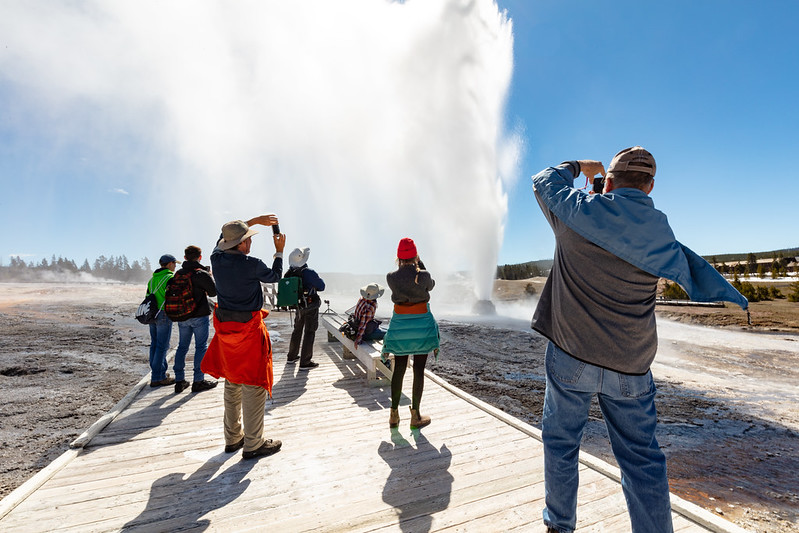
Beehive Geyser is located in the Upper Basin, just behind Old Faithful. Its eruptions are unpredictable but is one of the best in Yellowstone.
Near Beehive is a smaller geyser that can often be used as an indicator of a pending eruption of Beehive. This geyser, named Beehive’s Indicator, sends up a 6-to-15-foot (1.8 to 4.6 m) fountain between a few seconds and 30 minutes before Beehive erupts, averaging 15 to 20 minutes prior. Once Beehive starts erupting, the Indicator continues to play during part of the Beehive eruption and then stops. However, on occasion Beehive Geyser can erupt without the Indicator.
For a period of three years in the 1990s, Beehive was dormant. During this time, the Indicator would erupt for extended periods, as long as 60 minutes, with no Beehive eruption.
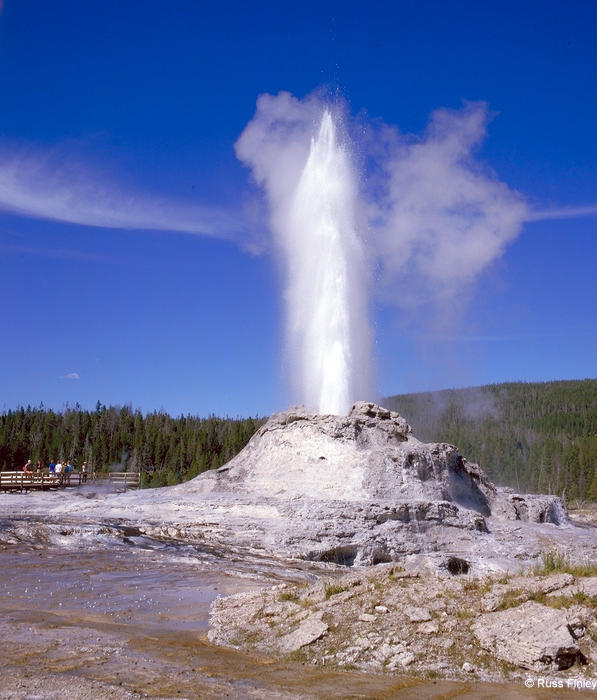
Castle Geyser is a very old geyser. Estimates put the age of its 12 foot high cone at 5,000 to 15,000 years. It would take that long to build such a large cone. Even more remarkable is that Castle’s cone sits on top of an even more massive sinter formation deposited by an even earlier spring. Castle is a cone-type geyser. Its interval is usually between 9 and 11 hours. Its maximum height is 60 to 90 feet. The 20 minute water phase of a major eruption is followed by a 40 minute steam phase. During the steam phase, the eruption mainly consists of forced steam with very little water. The first 10 to 15 minutes of the steam phase is relatively forceful and fairly loud and interesting to hear. As with most steam phases, the change from water to steam is gradual and an exact time for the change can rarely be noted. Castle occasionally has minor eruptions which last only a few minutes. These minors start similarly to the major eruptions but abruptly stop after a few minutes. When this happens, Castle becomes unpredictable until it has its next major eruption.
Named by the Washburn-Langford-Doane Expedition “The Castle,” situated on the summit of an incrusted mound, has a turreted crater through which a large volume of water is expelled at intervals of two or three hours to the height of 50 feet (15 m), from a discharging orifice about three feet (0.91 m) in diameter. The architectural features of the silicious sinter surrounding it, which is very massive and compact, indicating that at some former period the flow of water must have been much greater than at present, suggested its name. A vent near it is constantly discharging a large stream of boiling water, and when the geyser is in action the water in this vent boils and bubbles with great fierceness.

Clepsydra Geyser, located in the Lower Geyser Basin, is named after a Greek water clock. During the 1800’s it’s intervals were almost exactly 3 minutes. After the 1959 earthquake it entered what is known as a wild phase, erupting almost continuously. Sometimes it quits during Fountain Geyser’s eruption.
Cliff Geyser is located in the Black Sand Basin which is part of the Upper Geyser Basin. Eruptions are common but unpredictable. It’s cliff like cone sits on the edge of Iron Spring Creek.

Cliff Geyser is a clear pool in a geyserite ring that sits along the river bank. Round, bulbous geyserite fills the ring and forms the outer edge, but outside the ring pea-sized geyserite covers the surface. Hard sinter covers the further surrounding area. Some orange thermophiles exist in the area where Cliff Geyser drains. While Cliff Geyser has a varied history, recently it seems to be following a cycle of draining, then minor eruptions while the area fills, eventually resulting in a major eruption, the pool drains and remains quiet for a period before starting the cycle again. The interval between cycles can be up to 35 minutes.
Cliff Geyser has an average temperate of 174.3°F (79.1°C), an average pH of 6.1, and an average conductivity of 2295 uS/cm.

Daisy Geyser
Daisy is usually the most predictable of the predicted geysers. This coupled with its relative frequency, makes Daisy one of the easiest geysers to see. The exception to this rule is when nearby Splendid Geyser is active. Fortunately, for those that like Daisy, Splendid is rarely active. Unfortunately, Splendid is arguably the more spectacular geyser.
Daisy is a cone-type geyser. Its interval is usually 90 to 110 minutes, its height 60 to75 feet and its duration 3 to 4 minutes. When Daisy Geyser is regular (in other words, when Splendid is not active) you can usually predict the eruptions very accurately using the current average interval. In fact, this is so accurate that the Rangers often predict two eruption of Daisy in advance just using the interval.
But, what happens if you don’t know when Daisy last erupted or what its current interval is? Well, there are a couple of things you can look for.
First, don’t confuse the locations of Daisy and Comet Geysers. Comet is a nearly constantly active small geyser with a large half cone located in the center of the Daisy Group. Daisy is located closer towards the hill you walked up to get to the Daisy Group. It too is surrounded about halfway by a sinter rim but this rim is shorter than Comet’s. On Daisy’s rim are located two small cones. Each of these is a small geyser. The smaller of the two cones starts erupting about 20 to 30 minutes before Daisy. The larger of the two cones starts erupting about 10 to 15 minutes before Daisy. Thus, by watching these two cones you can get a good idea of how close you are to the next eruption.
Echinus Geyser is located in Norris Geyser Basin. Echinus is the largest acid-water geyser known. it was once a very predictable geyser but now eruptions are rare. It’s large pool slowly fills with water prior to an eruption. When the eruption begins each burst is different from the others. Some reaching heights of 125 feet. Late in 1998, this geyser altered its interval and for the next few years became less frequent and predictable.
For the last several years, Echinus eruptions have been extremely rare. When active, its pool fills gradually with water; then suddenly, bursts of steam and water explode 40 to 60 feet (12 to 18 m) skyward. Eruptions can last from about 4 minutes to as long as 118 minutes.
The major eruptions were believed to be caused by a secondary water source which has mysteriously vanished. Like other geysers and hot springs, Echinus Geyser can change without warning, and is subject to many unseen changes and forces underground.

Fountain Geyser is a classic fountain type geyser, erupting from a pool of water and characterized by it’s splashing action. This geyser is not easily predictable but has an average interval of around 11 hours.
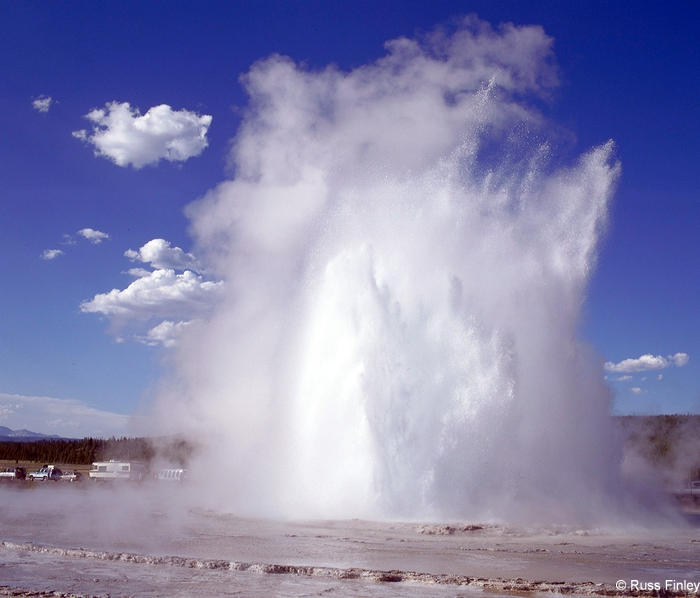

Great Fountain Geyser is located in the Lower Geyser Basin on the Firehole Lake Drive. Eruptions average 100 feet (31 m) high, with some rare “superbursts” of 200 feet (61 m) or more. Eruptions last 45-60 minutes in a series of bursts. Great Fountain Geyser takes 10-14 hours to rebuild to an eruption. The pool slowly fills, then begins to overflow 70-100 minutes before the eruption.
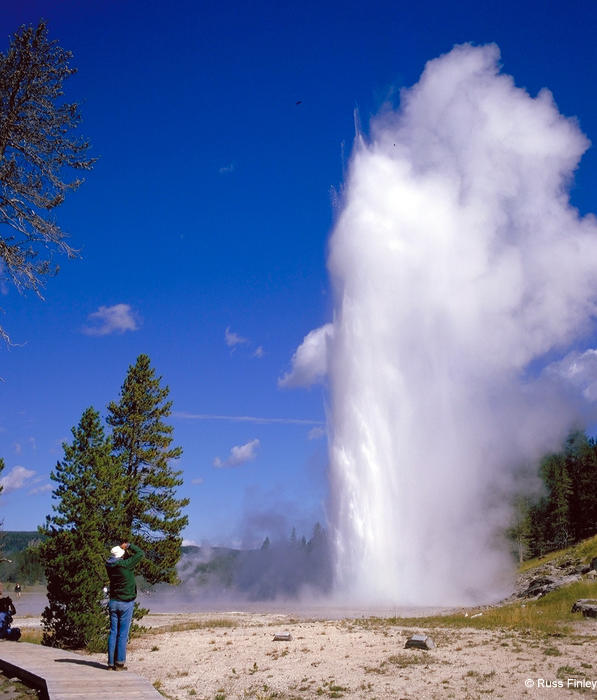
Grand Geyser is consistently the tallest and most spectacular of the predicted geysers. This excitement doesn’t come without a cost though. It has the largest prediction window of the predicted geysers. Even so, it is worth waiting to see. Grand erupts from a pool of water making it a fountain-type geyser as opposed to Old Faithful which is a cone-type geyser. Grand’s interval is usually around 8-12 hours, its height about 150-180 feet and its duration is about 10-12 minutes. It will often stop after about 9 minutes and then restart after a minute or so. This second “burst” and any subsequent bursts are often among the tallest if not the tallest of the eruption. Be sure to wait and see if there is a second burst. It is easy to get confused when looking for Grand Geyser. Of course, the Park Service has put out a sign to help you but the first thing most people notice is the large raised rim around nearby Turban Geyser and they miss the large flat pool just to the right of Turban. This large pool, with almost no rim, is Grand Geyser. Grand is closely related to Turban Geyser. During the hours prior to an eruption of Grand, Turban erupts approximately every 20 minutes. When Grand Geyser erupts, it does so just before or after the start of an eruption of Turban Geyser. If Grand doesn’t start at this time, you’ll have to wait another 20 minutes for the next eruption of Turban and hope Once Grand erupts, there is the possibility of more than one burst. A Grand burst is defined as the continuous eruption of water. The shorter the first burst, preferably less then 10 minutes, the more likely it is that you will see a second, third or even more bursts. (The most bursts seen in one eruption during the last few years is 11 but the average is usually 2 to 4.) After a burst has ended, watch Grand’s pool. Sometimes the water will be out of sight, sometimes it will still be visible. Watch to see if the water rises. If the water rises and begins to bubble be prepared for a spectacular sight as Grand erupts to its full height in one continuous motion. If the water drops, well, there’s always the next eruption.
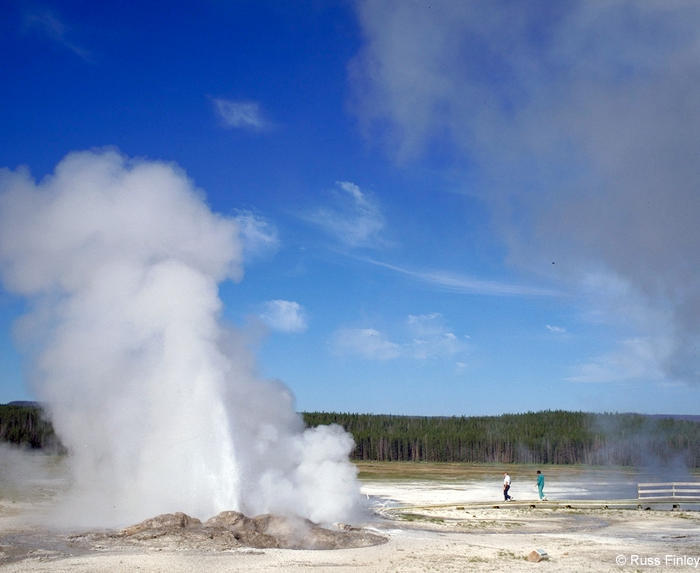
Jet Geyser is closely related to Fountain Geyser and is most frequent when Fountain is erupting. Jet erupts from at least 6 different vents, with the central one reaching heights of 20 feet. Jet Geyser plays in the hours leading up to an eruption from Fountain Geyser. During its active period, Jet erupts every few minutes .
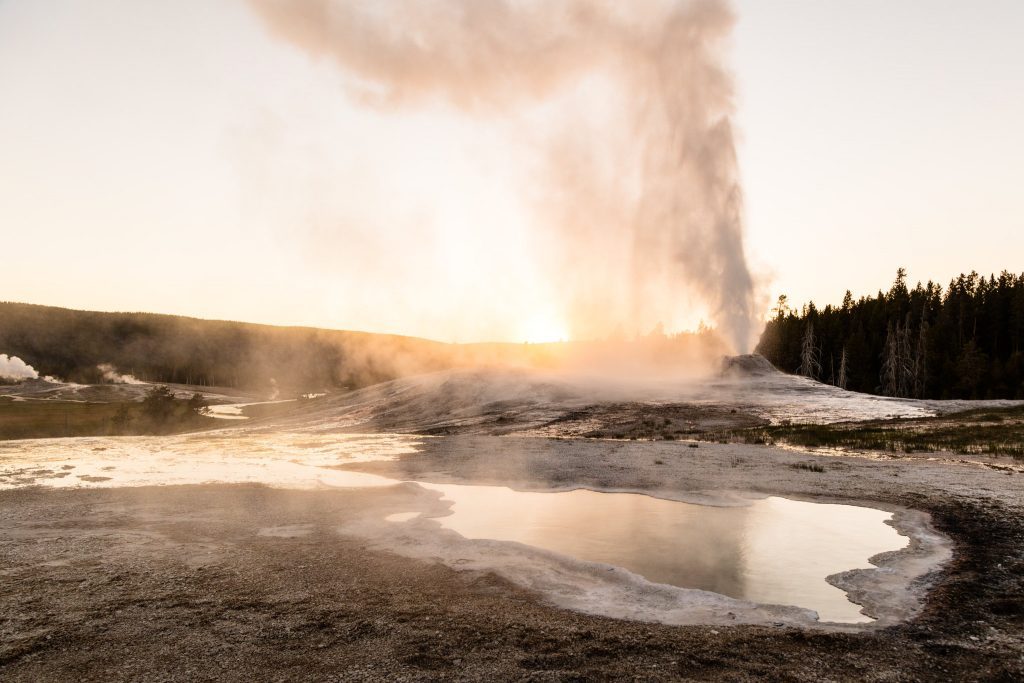
Lion Geyser is the main feature of the Lion Geyser Complex which includes Little Cub Geyser and the currently inactive Big Cub and Lioness geysers. Its eruptions issue from the largest cone of the group.
Eruptions reach heights of 50 feet, but in 1988 an eruption reached 98 feet. It was named for the roaring sound of steam releasing during an eruption. Eruptions can reach 90 feet (27 m) and last from 1 to 7 minutes.
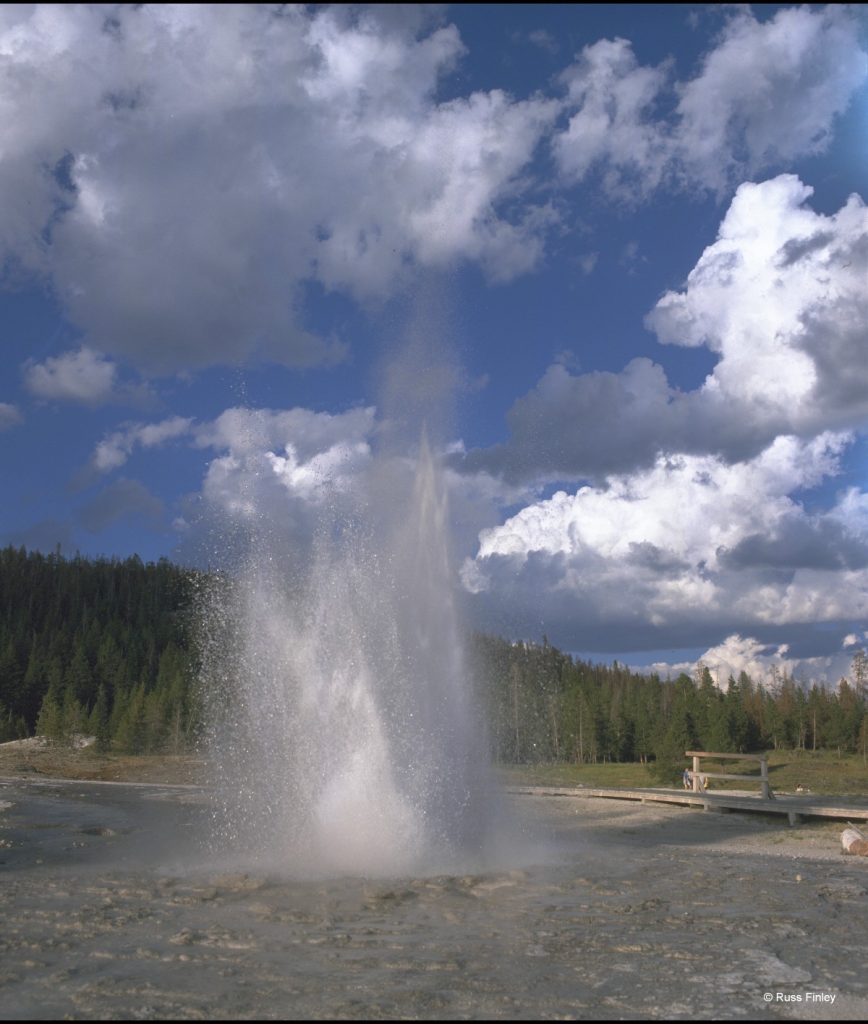
Plume Geyser was created in 1922 when a steam explosion created it’s surface vent. In 1972 another steam explosion enlarged it’s vent. Plume has undergone a number of activity changes but currently erupts about every 20 minutes. Its 3–5 quick bursts can reach heights of 25 feet (8m). Plume Geyser has an average temperate of 191.2°F (88.5°C), an average pH of 8.3, and an average conductivity of 1961 uS/cm.

Riverside Geyser has one of the most picturesque settings of any geyser.
Riverside is a cone-type geyser. Its interval is usually 5 1/2 to 7 hours, its height about 75 feet and its duration about 1/2 hour. The water phase of the eruption lasts about 20 minutes and is followed by a steam phase.
You watch Riverside from a viewing area across the Firehole river from the geyser. From this position, Riverside’s formation looks something like a chair.
There is a vent high up on the back and another vent in the seat of the chair. Except for some minor splashing, the geyser erupts from the lower vent in the seat of the chair. About 1 1/2 to 2 hours before the eruption the main vent in the seat of the chair begins to overflow into the river. This overflow is variable. About an hour later, the small vents behind the main vent will begin to bubble and boil. The activity fluctuates but seems to build as time progresses. Finally a splash or two will be seen in the upper vent at the top of the chair back. One of these splashes will be large enough to spill water into the river, this usually starts the eruption.
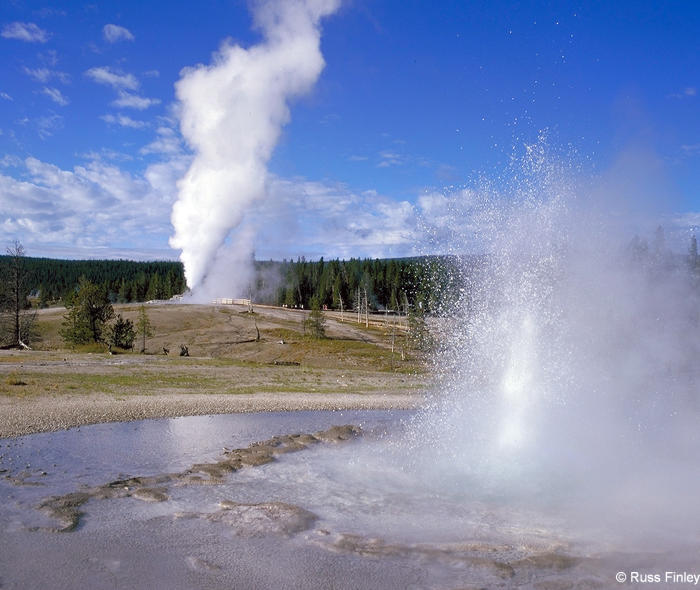
Sawmill Geyser is a classic fountain type geyser, erupting from a pool of water. Eruptions are in a series of bursts reaching heights of 35 feet.

Steamboat Geyser is the world’s tallest active geyser. Its major eruptions shoot water more than 300 feet (91 m). In Yellowstone National Park’s recorded history, only two other geysers have exceeded Steamboat in size: Excelsior Geyser in Midway Geyser Basin and Sapphire Pool in Biscuit Basin. Steamboat’s minor and major eruptions are entirely unpredictable.
Steamboat’s major eruptions generally last from 3 to 40 minutes (a couple of durations surpassing an hour were observed during the 2018 active phase), and are followed by powerful jets of steam. During these eruptions, water may be thrown more than 300 feet (91 m) into the air. Steamboat does not erupt on a predictable schedule, with recorded intervals between major eruptions ranging from three days to fifty years. The geyser was dormant from 1911 to 1961. In 1964, twenty-nine eruptions were reported,[8] setting the record for the most eruptions within a calendar year. In 2018, the geyser began a prolonged period of frequent activity lasting through at least 2022, with more than 40 eruptions recorded annually in both 2019 and 2020.
Minor eruptions of 10 to 15 feet (3.0 to 4.6 m) are much more frequent.
After an eruption, the geyser often vents large amounts of steam for up to 48 hours.[9] Sometimes during this part of an eruption, water may return to Steamboat, causing it to jet water once again, though to lesser heights.[6] Cistern Spring, located nearby, will drain completely following a major eruption of the geyser; the spring refills within a few days.

White Dome is a very old geyser as it’s 20 foot high cone suggests. Eruption occur thru a 4 inch wide vent and reaches heights of 30 feet.

